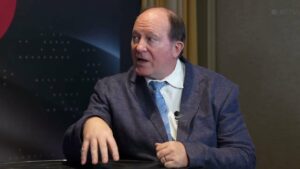A NEW developing mining district in the state of Guerrero, Mexico, the Guerrero Gold Belt, has attracted some exciting explorers that have unearthed key discoveries. While several companies have gone on land-grabbing sprees, there’s still good news: the Guerrero is growing.
Merrill McHenry, metals and mining analyst with Industrial Alliance Securities in Toronto and an expert on the area, believes the Guerrero could be more than twice as large as it’s currently definedpotentially becoming one of the largest gold districts in the world. In this interview with The Gold Report, McHenry discusses the Guerrero Gold Belt and the impact of the evolving Cyprus financial crisis on gold.
The Gold Report: Merrill, you joined Industrial Alliance at a time when many junior companies are having difficulty getting financing.
In fact, newsletter writer John Kaiser reported that of the 527 companies exhibited at the PDAC International Convention this month in Toronto, 114 had less than $200,000 in working capital and about half had market caps of less than $20 million ($20M).
None of the companies that you cover are that low on cash, but one will need to go to market within a year or so. Is that a concern?
Merrill McHenry: That is a concern for many companies, but most of those that I have under coverage have enough in the till such that their development and/or exploration are fully funded for up to two years, in some cases much longer.
TGR: You specialize in the Guerrero Gold Belt (GGB) and have an extensive geological knowledge of Mexico. Mexico’s ranked 10th in global gold production with 86.6 metric tons (86.6 mt) or roughly 2.78 Moz produced annually. However, Mexico’s year-over-year gold production is growing at almost 14%, the fastest growth rate in the world. What role does the GGB play in that?
Merrill McHenry: A role of great significance. Currently, the GGB is at 15.39 Moz in the Reserve category. The highest category, NI 43-101 compliant, is 34.2% of total gold Reserves in Mexico. We forecast, based upon the 10-year average, an annual growth rate in resources in the GGB of 600,000 ounces (600 Koz) a year.
That’s not even taking into account that there are 3040% more drill rigs operating in the GGB than there were one year ago.
Several companies are on maiden drill programs in 2013, which more than doubles the amount of activity that has gone on in the past in the GGB. We expect a transformative year for the GGB with a significant upward rerating.
We expect substantially more growth for total gold reserves in the GGB than the projection that I just gave you. The GGB currently has 20.59 Moz NI-43-101-compliant resources.
TGR: An interesting aspect about Mexico is the cost of production. You peg cash costs at about $325/oz (based on Thomson Reuters data) versus the industry average of more than $600/oz. That’s a pretty massive difference.
Merrill McHenry: In Mexico, because of the plate tectonics and the mineralogical events that occurred, many projects are oxidized instead of being sulfide. If they’re oxidized, as in the case of the GGB, a lot of the resources can just be dug up, trucked over to the leach pad and dumped. They don’t have to mill and use a lot of chemicals and processing in the milling. Quite often, you really can’t get much cheaper than the oxide resources that are prevalent in the GGB. It gives us some of the cheapest gold production costs in the world.
Moreover, with the 29% year-over-year mining industry cost escalation in the last seven years, companies need low-cost ounces. That’s what the GGB and district scale offer. Synergies in scale and mining resources bring low oxide mining costs even lower.
TGR: The GGB is a 40 kilometer (40 km) long trend?
Merrill McHenry: It is a 70100km long area. The intrusives that created the mineralization in the GGB are prevalent over a large area and therefore the GGB couldwe expect willextend significantly.
TGR: Market sentiment for gold is somewhat flat, but you believe gold will rebound. Make your case.
Merrill McHenry: Actually, I don’t need gold to rebound. For 29 years, I’ve operated under Keynes’ mantra of “I’d rather be vaguely right than precisely wrong.” I don’t need the 100% returns post Global Financial Crisis, nor do I expect the gold price to appreciate significantly from here. The requirement that the price of gold goes up doesn’t necessarily need to manifest itself. It just needs to not collapse in order to have very attractive earnings for the majors.
There is a debt-cycle restructuring going on in the US. For approximately 40 years, debt fueled growth. The debt to gross domestic product (GDP) ratio was approximately half of what it was at the end of the last debt cycle that ended in 2008. In the Depression, it was 255% of GDP. In 2007, it was 380% of GDP. The US private sector balance sheet is trying to heal from roughly 150% of the debt/GDP ratio it had in the Depression. No one wants to use the big “D” word, but the debt cycle and long and slow restructuring are similar in effect.
We don’t need to say with certainty the amount of years or the length of time that it will take for the private sector balance sheet repair to transpire in the US I don’t see it being resolved any time soon. Private sector debt growth has been flat since the global financial crisis. Arguably that is the reason for the quantitative easing and federal deficits to stimulate growth that would otherwise not be occurring.
It takes a while to slog into a downturn and it takes a while to slog out of a downturn, but we could have a rotation faster than many think.
TGR: The price of gold jumped above $1,600/ounce after the tax on Cyprus bank assets was announced. Although the Cypriot Parliament has voted it down, is that a sign of things to come if the same “bail-in” is applied to Spain and other Euro countries?
Merrill McHenry: The Cypriot problem is extremely complicated, as well as precedent setting with bail-ins and a good bit of Germany’s first “just say no” to EU backstopping. Exogenous material market events can definitely be market moversand this may light a fire under gold, the degree of which is still fluid. In this case there are significant international twists in addition to the EU and European Central Bank; there is also a lot of Russian money stowed away in the Cyprus banking system. The ability to put a bail-in haircut on Russian deposits is a wildcard as Cyprus has a much needed 2.5 billion Russian loan, a 1.4 billion international bond payment in June, and Angela Merkel and the EU get 36% of their natural gas from Russia, which could use it as a bargaining chip. This has many plots and subplots to it.
In its broadest sense, this is a manifestation of the increasingly unbridgeable expectations by populaces worldwide regarding benefits and obligations, aka spending vs. revenue. Cyprus was considered a “tax haven” so clearly its fiscal policies have not backed its banking system, which is awash with foreign, largely Russian, monies. In Cyprus, a bail-in fix by depositors would have indicated that the country intended to continue the favorable 10% top tax-bracket tax regime.
With gold as the only non-sovereign reserve for central banks, it is at a minimum a reserve asset without an increasing liability in a world where that is a norm. While we cannot tell if gold becomes an increasing asset de jour and commensurately takes off in price, we do at least have the visibility that it should remain in demand, holding its ability as a store of valuewhile many sovereign credits and currencies appear to be in a race to the bottom.
TGR: Can you leave us with one reason for optimism in a gloomy market?
Merrill McHenry: Valuations for the gold majors are as cheap as during the global financial crisis. We’re pushing the end of a quarter. Historically, portfolio managers and active mining managers tend to both preserve gains and avoid losses at the end of a quarter and, importantly, rotate and seek out new alpha or new returns above the benchmark for which they’re compensated and bonused at the beginning of quarters. Next month will be the beginning of a new quarter, and perhaps some reallocations will come back into the gold sector.
TGR: Thanks for your insights, Merrill.

















